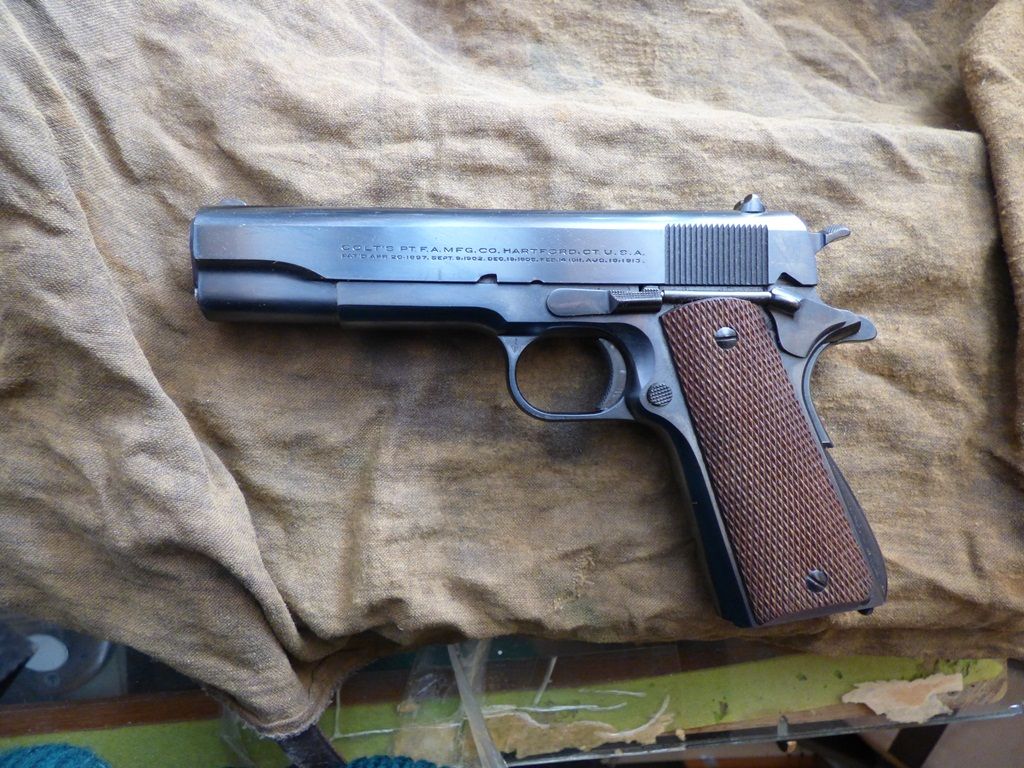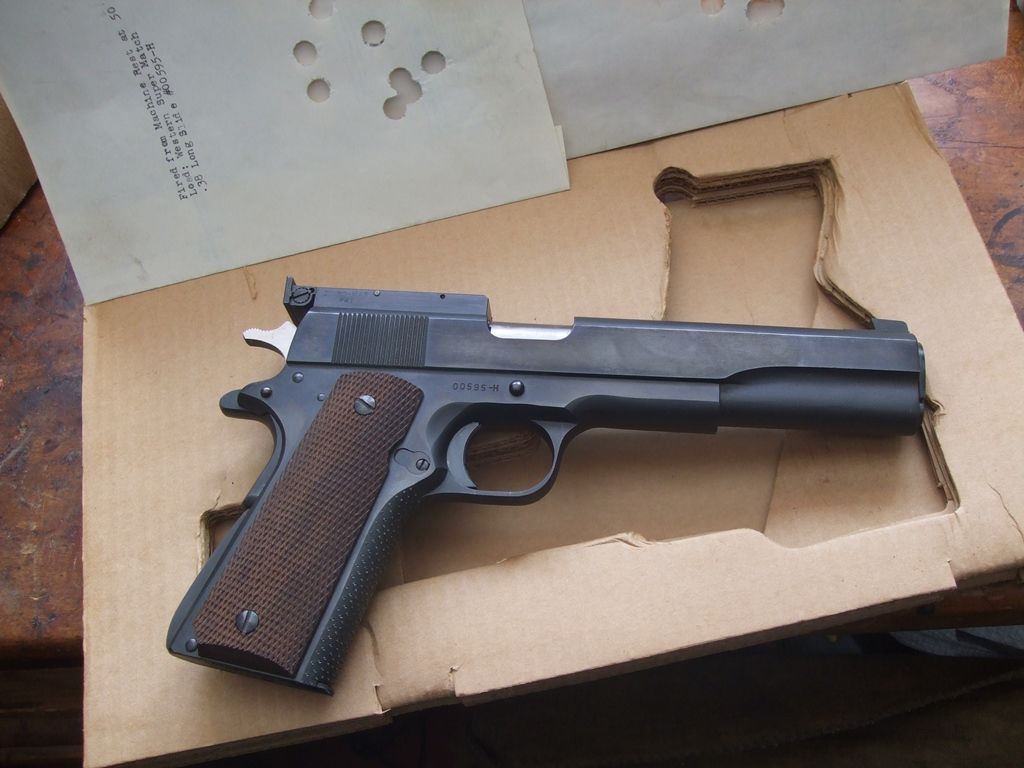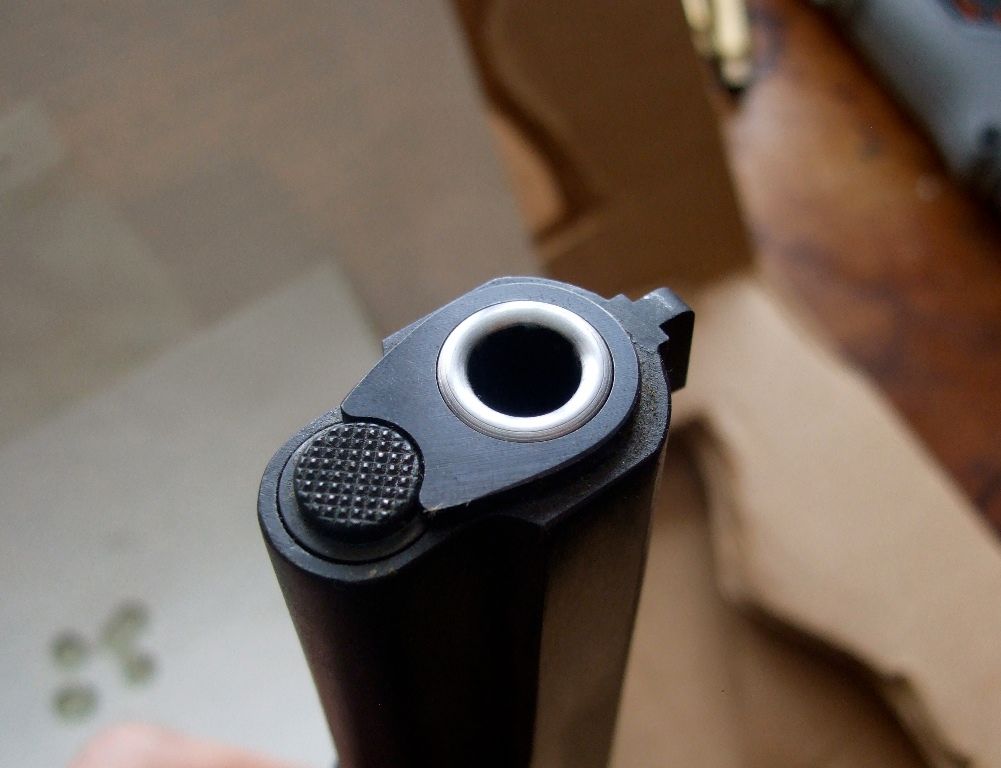|
|
Post by Lee Martin on Feb 24, 2015 19:27:58 GMT -5
Mint pre-WW II commercial Colt M1911.  NIB Jim Clark long slide Colt 1911 .38 Special, 1963. Full papers and 50 yards targets.   -Lee www.singleactions.com"Building carpal tunnel one round at a time" |
|
cmh
.401 Bobcat
  
Posts: 3,745
|
Post by cmh on Feb 24, 2015 19:46:48 GMT -5
As always your collection impresses me Mr Bradshaw. Thank you
|
|
|
|
Post by bradshaw on Feb 24, 2015 21:39:28 GMT -5
cmh.... these are not my firearms; access provided for photographs. Thank you for the appreciative comments, which we may direct toward the guns. Another correction: Jim Clark rebuilt the Colt 1911 into a long side .38 Special wadcutter gun in 1968 (not 1963 as stated above). Besides building championship winning pistols, Clark was himself a crack rifleman and pistol champion. Packed a big funny bone in his tough-as-nails self.
David Bradshaw
|
|
|
|
Post by bradshaw on Feb 26, 2015 3:30:59 GMT -5
.38 Special Wadcutter, auto pistol
There was a time revolvers dominated bullseye and bullseye was the only game in town. Classy Colt and Smith & Wesson double action revolvers with adjustable sights reigned supreme. Autos, especially bull barrel High Standards, pushed aside the Colt Officers Model Match and S&W K-22 in the rimfire category. With Colt's 1911 pervasive in the military, armorers learned to accurize the warhorse. Accurized 1911's soon displaced the big bore revolvers of Colt and S&W. The auto was easier to control, especially in rapid fire. A revolver shooter cocked the hammer. Nobody shot bullseye double action. I saw .38 revolvers alongside .22's and .45's in the gun boxes of bullseye shooters. But it had become an anachronism to cock the hammer for each shot in rapid fire.
While the .38 game lasted, Jim Clark worked to make the .38 Special----shooting wadcutters----competitive. the job of a wadcutter is to cut a clean hole and grab the highest scoring ring possible for that diameter bullet. The wadcutter was a revolver bullet, never intended for smooth feed from a magazine. To illustrate the challenge, try speed loading your DA revolver with wadcutters.
Smith & Wesson got into the act with its Model 52, to my knowledge the only factory .38 Special auto pistol. A straight-up target pistol, the M-52 was designed for wadcutters. S&W took high speed film of the M-52 in action and answered a suspicion. A flinch could tip the bullet as it departed the muzzle. That shot is doomed. I imagine the greater muzzle heft of Jim Clark's longslide 1911 should diminish the yaw potential.
A bit of biography on Jim Clark may be found at bullseyepistol.com/clark.
David Bradshaw
|
|
tgc
.30 Stingray

Posts: 142 
|
Post by tgc on Mar 4, 2015 19:32:01 GMT -5
Those are nice. No long beavertails and picatinny rails for these folks.
Wonder what it would cost to puchase a colt .45 just before ww2 ?
|
|
snappy
.30 Stingray

Posts: 421
|
Post by snappy on Mar 4, 2015 22:04:54 GMT -5
The front strap on that Clark long slide looks interesting. Almost looks like some kind of "stippling" rather than checkered, at least to my eyes. Always thought provoking stuff Mr Bradshaw.
|
|
|
|
Post by bradshaw on Mar 5, 2015 4:05:20 GMT -5
tgc.... a test of my memory...
retail prices around 1960:
* Ruger Standard .22 Auto Pistol----$37.50.
* Mossberg .22 rifle, bolt action 26" bbl; hooded front sight w/4 inserts; open & swing-away micrometer-click aperture rear sights; QD swivels; walnut stock; tube magazine holds 30 Short, 25 Long, or 20 Long Rifle; trigger adjustable for weight; very accurate & utterly reliable----somewhere between $20 and $36.
* Remington Nylon 66 .22LR----$50. Advertised heavily for over a year before entering the pipeline.
* S&W M-36 Chief's Special .38 Spl.----$60.
* Colt 1911----$75.
* Ruger Blackhawk .357 mag----$87.50.
* S&W M-28 Highway Patrolman----$85.
* S&W M-27 .357 mag----$120.
* Colt Python .357 mag----$125.
* Colt SAA----$125.
* Ruger Super Blackhawk .44 mag----$116.
* S&W M-29 .44 mag----$140. (Bought my first M-29 for $118----$5 over dealer.)
* Springfield Armory (the real Springfield Armory) M1 Garand National Match----$136. Price to shooters issued an NM M1.
M-27 and M-29
It was my impression that the M-27 tapered barrel with checkered rib, and checkering on top strap and sight, made made production costs higher than for the M-29. Nevertheless, the M-29 was the new prestige mobile of the S&W line. And rightly so, since the .44 Magnum was the new king, and factory ammunition steamed velocity and unmistakeable wallop. The M-29 came in an attractive wood box. All S&W's came with cleaning rod, bronze brush, and a beautiful flat ground screwdriver for removing the sideplate.
M-28
Years later, when I met Bill Ruger, I would hear him describe the S&W Highway patrolman as "A true bargain."
snappy.... the raised stippling on the front strap is trade mark treatment on a Jim Clark 1911 target pistol. Consistent enough to be called "Jim Clark engraving," and----should you be so inclined----sharp enough to fashion spare grips for your hogleg.
David Bradshaw
|
|
|
|
Post by contender on Mar 5, 2015 10:13:26 GMT -5
Great info David. However, Colt did offer a 38 Special semi-auto. It was a National Match, MKII/MKIII, shooting a mid-range 38 spl. I got educated on them about a year or so ago when I was able to purchase a batch of factory magazines from a serious 1911 shooters estate. In that batch were a few factory 38 spl magazines.
|
|
|
|
Post by bradshaw on Mar 5, 2015 12:56:41 GMT -5
contender.... thanks for the correction. Somewhere in the dust of memory lurked a phantom picture of a Colt 1911 .38 Special. A quick look around confirms said pistol. The old bullseye discipline recognized three categories of competition----1) .22, 2) Centerfire, includes .32 and .38, and 3) .45. Charles Askins, another national champion, wrote of working with a .32 caliber auto pistol----likely .32 S&W rimmed case----with the goal of reducing recoil below that of the .38 Special, as time spent recovering from recoil steals time from sight alignment & squeeze. This is the guy who called .44 Magnum recoil stimulating, suggesting that anyone wears a glove to protect their hand from the M-29 must "have lace on his pants."
The Centerfire category probably came from widespread service use of DA .38 revolvers, with Smith & Wesson and Colt building beautiful revolvers to satisfy the legion of pocket pool offhand shooters----whose skill, by the way, cannot be sneezed at without risk of a bloody nose.
Would seem the first job in building an auto pistol for a recoilless cartridge is to make it a straight blowback.
David Bradshaw
|
|
|
|
Post by AxeHandle on Mar 5, 2015 14:45:17 GMT -5
"Tiger Tooth" was what Clark called his stippling. A tell for a Clark gun is the Tiger Teeth rows are in an offset pattern. It should be of value to note that when the revolver ruled the Bullseye roost there was no such thing as an alibi string to make up for a malfunctioning gun. The alibi rule allows the competitor to fire a make up string for each sub aggregate. That allows for three make up strings each for the 22, centerfire and 45.. This provided a toe hold for the autos that allowed them to take over. Colt did make a very limited run of NM 38 Special 1911s but the Customs you see out of Bullseye builders like Clark, Giles and others were built on the 38 Super. The 5 inch Clark 38 Special used the rechambered 38 Super barrel. I heard that it was the 38 Super based 38 Special 1911s that had the rep for easy key holing. There have been other 38 wadcutter guns built for the paper punchers. The SIG Hammerli P240 is one. The USAMU made up a rimless 38 Special, called the 38 AMU, they tried for a while. FWIW Clark was most likely the only pure civilian, never shooting as a government sponsored shooter, to win the Bullseye National Championship at camp Perry. Seems like it was about 1956. Right at the end of the revolver domination, he was shooting revolvers at that point it time.
|
|
cj3a
.30 Stingray

Posts: 403
|
Post by cj3a on Mar 5, 2015 20:31:22 GMT -5
 Colts in 38 and 45. |
|
Otony
.327 Meteor
 
Posts: 722
|
Post by Otony on Mar 6, 2015 7:21:06 GMT -5
As AxeHandle mentioned, don't forget the very rare SIG-Hammerli P240, made in .38 Special wadcutter, as well as .32 S&W Long, and even .22LR. Here is an example: jamesdjulia.com/item/lot-1282-very-rare-sig-hammerli-p240-semi-auto-target-pistol-38064/Mr. Bradshaw, I belive you may be referencing a Colt Match Woodsman converted by Charlie Askins to a centerfire.22 target pistol utilizing .22 Velo Dog brass. The powers that be within the Border Patrol were so incensed at his manipulation of the loopholes in the rules for suitable pistols utilized for target shooting (thereby creating, in essence, an unbeatable shooting machine) that they ordered him to stop the use of his Q-ship Colt forthwith. He, equally incensed with what he saw as them meddling in his affairs, terminated his employment with the Border Patrol, and didn't let the door hit his posterior on the way out! |
|
|
|
Post by AxeHandle on Mar 6, 2015 9:47:21 GMT -5
|
|
|
|
Post by AxeHandle on Mar 6, 2015 10:04:12 GMT -5
Okay... Now let's discuss stuff you guys need to recognize about that "Mint pre-WW II commercial Colt M1911." While I'm no 1911 expert that one is no 1911. Looks like a mix of parts to me. I see a 1911 slide, based on the patent dates on the slide, and for sure a 1911A1 frame, based on the short trigger, arched mainspring housing, long grip safety tang, and relief cuts in the frame behind the trigger... Need to see the other side for the serial number to call out the manufacturer and actual year of production. May not even be a Colt!
|
|
|
|
Post by bradshaw on Mar 7, 2015 9:13:00 GMT -5
Otony.... thanks for the info and anecdote on Charles Askins. Bought his book while in my mid-teens. Book may have grown legs, or perhaps it molders in a box with books by Ed McGivern and Bill Jordan. Can you describe the cartridge used by Askins? Askins was just going for an EDGE, no different, really, than Skip Talbot soliciting Ron Power to build a single-shot Model 27 for competition in the new Revolver category of early rip-snortin' IHMSA. The M-27 would have been a swing-out single shot. (Talbot also wanted to shoot a Vern Juenke T/C Contender in Production (closed breech----aka production single shot.") That got me boiling and I lead the charge to keep revolvers absolute stock, save for a trigger job with factory parts only, and standard aftermarket grips.
Skip Talbot was as fierce a competitor as ever strode to the firing line. Fierce as Elgin Gates. Both former championship boat racers and spectacular shots, Elgin having proven it with four International trap championships at Vandalia. Talbot and Gates had a falling out over the production rules: Skip wanted no "visible" modifications; Elgin insisting on "no" modifications.
... a vignette from the old days.
Axehandle.... looked up Colt serial numbers on sightm1911.com....
The "Mint pre-WW II commercial Colt 1911" pictured in this series falls within 3,000 commercial Model 1911A1's made in 1930, which S/N's span C156000 to C158999. I believe Ben "Bear Man" Kilham, whom worked at Colt, and is an accomplished smith in his own right, could detect a gun cobbled together from parts.
For my generation, "pre-war" means "pre-WW II." I'm not old enough for it to mean "pre-WW I" or "pre-Civil War."
David Bradshaw
|
|